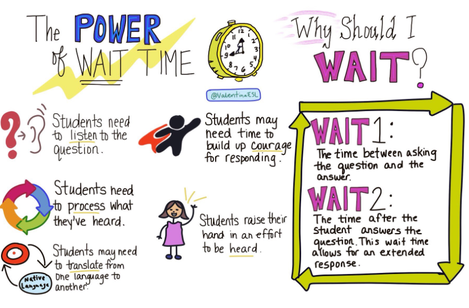Wait Time

Wait time refers to providing students extra time to process and respond to questions or prompts — a seemingly simple step, but one that can lead to increased student engagement. This strategy is part of Colorín Colorado's ELL Strategy Library and can be used to support academic language development for all students.
Strategy Overview
How This Strategy Supports Students' Language Development
Students who are learning a new language may need additional time to understand a question or task, process what is being asked of them, and then formulate a response in their new language. In addition, they may be going through a "silent period," in which they are listening and absorbing language but not yet saying too much. Teachers may move on quickly because they think the student doesn't know the answer, but providing just a few seconds of additional "wait time" can make a significant difference.
Valentina Gonzalez cites research from Mary Budd Rowe (who coined the term "wait time") showing that doubling wait time from 1.5 seconds to 3 seconds can result in positive impacts, such as an increase in the number of students volunteering to answer a question, the length of their responses, the number of correct responses, and student confidence. Rowe's research also shows that increasing wait time leads to fewer students responding, "I don't know."
Step-by-Step Instructions
- Monitor the amount of wait time you are currently offering, both in whole-class instruction and in one-on-one conversations. How many seconds do you wait for a response? How long do you wait before moving on to a new student? Is there a difference when you are in front of the class or speaking to an individual student?
- Try increasing wait time by 3-5 seconds before calling on students. It may feel unnatural at first, but don't give up, especially when calling on ELLs.
- Ask students to show a signal (thumbs up, raise hand, stand up, etc.) when they are ready to answer. This signal will give you an indication of how long students need to think about the answer.
- In addition, try adding extra wait time after the student first responds to see if they add anything else.
- Use sentence frames as a scaffold if needed to support student responses.
- Teach your students to increase their wait time as well to allow sufficient time for peer responses.
- Look for ways to increase student talk time throughout the classroom, such as in "turn and talk" activities. In addition, use wait time in "turn and talk" activities as well, waiting a few seconds after giving a prompt before getting students started in discussion.
- If you notice a positive difference after using wait time, share these results with colleagues so they can try increasing wait time as well.
Note: ELL expert Tan Huynh says that while you may wish to repeat the question, avoid re-phrasing the question, which can lead to increased confusion for students. He has also taught his students the following phrases:
- Can you say that again slower? OR
- Can you rephrase the question?
Differentiation
Entering/Emerging:
- Provide students with sentence stems, as well as practice using those stems in small group settings.
- Translate all question words into all the languages spoken by students in the class. Post the question words and their translations on the wall, pointing to them when you ask questions. Include question words such as:
- Who?
- What?
- When?
- Where?
- Why?
- How?
- Give students opportunities to answer questions with a partner or in small groups before calling on them in front of the whole class.
- Write the question or key words from the question on the board so students can process the question with visual as well as auditory clues.
Developing/Expanding:
- Offer students an opportunity to expand upon their answers by asking follow-up questions such as, "How do you know?" or "Is there anything you'd like to add?"
Lessons Learned
- Calling on students without giving them sufficient wait time can lead to decreased motivation; conversely, increasing wait time can increase engagement and motivation. Keep track of how student responses change when you add wait time.
- Give yourself time to get used to the different rhythm – one that doesn't reward the quickest response.
Co-Teaching Considerations
For Classroom Teachers
- Invite your ESL colleague to demonstrate what increased wait time looks like through a mini lesson. Take note of any differences you see in student participation.
- Divide the classroom into two smaller groups so you and your co-teacher can better monitor when students are ready to respond.
For ELL Specialists
- Share the idea of wait time with colleagues and explain why it matters.
- Look for opportunities to demonstrate what increased wait time looks like, modeling for colleagues or sharing possible scripts.
Examples
Here is an example of a teacher and student interaction with and without wait time. In addition, Valentina Gonzalez shares a sample wait time scenario in her blog post, "WAIT!! I'm not ready!"
| No Wait Time | Wait Time |
|---|---|
Teacher: Jacinda, what is the latitude of the Equator? Jacinda: Um… Teacher: Who can help Jacinda? Jennifer? Jennifer: The latitude is zero degrees. | Teacher: I'd like everyone think of what we just learned about latitude and longitude. Brief pause What is the latitude of the Equator? Wait 3 seconds Now, please turn to your partner and share the latitude of the Equator. After turn and talk… Teacher: Jacinda, what is the latitude of the Equator? Jacinda: Um…. Pause for 5 seconds Jacinda: Zero. Nod, smile, and pause for 5 more seconds Jacinda: My family lives near the Equator in Ecuador. |
Resources
- WAIT!! I’m not ready!” (Valentina Gonzalez)
- Check Yourself!: How Language Input and Wait Time Can Make or Break Instruction For English Learners (Confianza)
- Get Them Talking: Structured Student Interactions (Empowering ELLs)
- SIOP Feature #18: Provide sufficient wait time for student responses consistently (TESOL Trainers)




